Chapter 1: The Print
There is a lack of agreement as to the most apposite and euphonious name for the products of this delicate craft. It is variously called the color wood-cut, wood-block print, color-print from wood-blocks, wood-cut in color, and chromoxylograph. To enlightened enthusiasts, however, certain distinguishing features reveal its identity at a glance: no label is necessary. Even our unsophisticated friends who annoy us by remarking, "How Japanese," subconsciously recognize those characteristics which are peculiar also to a Japanese print, dimly remembered perhaps. The annoyance arises from the feared implication that we are copyists in subject or treatment, or both, whereas the common qualities that establish the relationship result merely from a similarity of method. Simplicity, which involves direct graphic statement and purity and transparency of color, is an essential feature, and one consequent upon the technique; a virtue easy of attainment. Regarded technically the craft is the simplest ever devised. It is the oldest too. No press is necessary; nothing save a plank and a knife to make the engraving, and paper, color, and brushes, with a printing pad (for which many things will serve) to secure an impression.
In the days of the illuminated manuscript the wood-cut was sometimes used for capital letters, but in outline only. The print was colored by hand. So were the earlier Japanese prints. Several authoritative historical accounts of the craft have been published, also complete descriptions of Japanese methods. It is unnecessary to deal with history here, but you—potential chromoxylographist, to whom I address these remarks—had better make an immediate, if for the present slight, acquaintance with traditional practice before we can discuss the physical aspects of the color wood-cut.
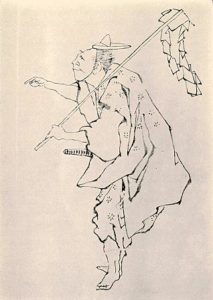
A Japanese artist's drawing for a woodcut (From a drawing by Hokusai, in the Victoria and Albert Museum)
THE TRADITIONAL JAPANESE METHOD. The artist made a drawing with the point of a brush and Chinese ink on paper of a landscape, an actor, a fish or a bird, and gave it to the block-cutter to engrave, with some instruction regarding color. The block-cutter pasted the drawing face down on a polished plank of mountain cherry wood. (Those who have heard that wood engravings are cut on the end grain of box-wood or maple must not confuse that process with this. Cherry wood is cut plank-wise: with the grain and not across it. The thickness is, roughly, one inch). He scraped away the superfluous thickness of paper, and oiled the remnant in order to render it transparent and so clarify the drawing. With a knife and a gouge he cut away the portions of wood uncovered by the drawing to the depth of perhaps one-eighth of an inch, so that eventually he had a facsimile of the original drawing in reverse in wood and in relief. He brushed over this a black powder pigment ground in water, and finally a little paste to bind it. Damp paper was superimposed and the back of it rubbed with a baren (a pad covered with bamboo leaf). An exact reproduction of the original drawing resulted. He pasted this on the other side of the cherry-wood block, and as before proceeded to lower that portion of the surface which in the finished print would be void of a certain color. A second print was taken from the first—the key-block—and pasted on a second block of wood, which he cut for another color. And so the process continued until all the requisite colors were accounted for, ten or twelve perhaps, when a second craftsman, the printer, took charge. The finished print was made up of impressions from each of the blocks dealt with successively. The system of making the several blocks fit, or of registering them accurately, is described later on.
There is a Japanese print in the British Museum depicting the various processes in the fabrication of a print. The exponents are young ladies. They were never employed for the purpose, but they grace the picture, and demonstrate things quite effectively.
The Japanese print of the best period is straightforward and simple: an outline in black filled in where necessary with flat washes of color relieved only by occasional gradations or patterns. Most processes at present in use are based upon it, and many modern artists find in the method an adequate vehicle for the expression of their own ideas. The thin, unemotional, but very expressive line is now expanded to indicate shadow and depth, or manipulated to suggest textural differences. Instead of being entirely negative in color—the Japanese line is gray, occasionally, as with Utamaro, flesh-red—it has become positive. In Miss Mabel Royd's or Miss Frances Gearhart's work, for example, it has the full value of black in the black and white wood-cut, and is originally designed with pictorial completeness. In William Giles' recent work it has vanished altogether as outline. Apart from its technical significance, in relation to Japanese practice, the retention of outline by modem artists is the result of their appreciation of its aesthetic value.
No modern maker of color-prints yet has attempted to adopt the stereoscopic perspective peculiarly Oriental, which is contrary to the laws of our somewhat conventional science. The cubists adopted it, and that was one of the most reasonable things they did, for the science of perspective is based on the doubtful axiom that we are equipped with only one eye—and that immovable. Hold a small box in the position depicted below, near to the eye, then vote for the more accurate presentment of what you see.

Of course this applies to very near objects only. But neither system is accurate applied universally.
While some of us follow somewhat blindly the traditions of Nippon, others actually employ Japanese craftsmen. An original print, however, one which may be signed by the artist with a clear conscience, is defined as one designed, cut, and printed by the artist, and exclusive societies, such as the Society of Graver-Printers in Color, of London, admit only these to their exhibitions.
SCOPE OF THE WOOD-CUT IN COLOR. Artists are perennially implored to consider "the limitations of the medium." Whoever invented this expression exaggerated the limitations of the English language. We are not concerned with what effects cannot be produced with our materials. As a matter of fact it is possible, if futile, to reproduce a water-color painting with fidelity. A great many color blocks would be needed, the hard edges of printing surfaces, the impressions of woodgrain, and other characteristics would have to be obscured: all of which we are rightly adjured to retain and to cherish. Mr. Platt very clearly calls this sentiment "the regard for material."
Happily simplicity, a great virtue in art, is here a necessity, or at least the result of the limitation of the number of blocks used. The skill attained by the Japanese craftsmen in the early nineteenth century, led them into useless technical complexities. Now it is almost entirely a reproductive medium. The pages of the "Kokka" abound in fine examples. All who frequent picture shops are familiar with the Japanese reproductions of drawings by Charles Bartlett, Elizabeth Keith, and Bertha Lum, and have enjoyed the perfect collaboration of Frank Brangwyn and Yoshijiro Urushibara. There is no question of degeneration. Urushibara has never been surpassed from the point of view of technique, it is only that the Japanese masters of painting have ceased to regard the color wood-cut as a means of original expression, in which the materials contribute to the beauty of the design as well as to its fabrication. We must so regard it. Lest I should seem to do Urushibara an injustice, I must add that in addition to his reproductive work he is responsible for some of the most interesting original prints of recent years.
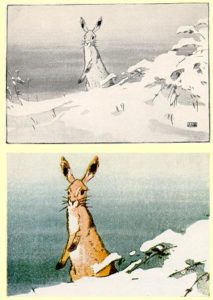
Hare by Allen W. Seaby
With a full-size fragment in color
GRADATIONS AND HARD EDGES. A beautiful feature in the color wood-cut, and one unique in printing, is color gradation. The impression of wood-grain is also unique and must be considered, not only as regards texture and visibility, but for the occasional possibility of the expression of form. A soft wood, with hard annulations, such as fir, prints very dearly.
The hard edges of all cut shapes—lines as well as color masses—are not peculiar to the wood-cut, but modifications are possible, and hard edges provide the necessity for sound and simple drawing.
Mr. Seaby's Hare admirably illustrates color gradation, achieved in the gray background by gradating color on the wood in the same way as on paper in water-color painting, and in the change from brown to white in the hare's fur by scraping the wood with a knife, thus creating a necessary texture also.
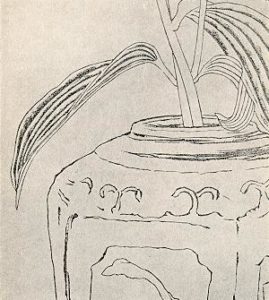
Full-size fragment of a line block by Y. Urushibara
In Urushibara's line print the leaf veins are soft on one side—an effect gained by slightly bevelling the wood with a knife or with sand paper.
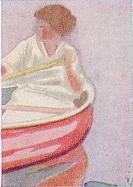
From Gloaming by the author
From Gloaming by the author. Local gradations are made in printing. Two brushes are sometimes used, one charged with more potent color than the other. Line blocks are nearly always printed with some variation of tone, and often in color too. The lost edges of the hair in the fragment of Gloaming were obtained by printing the dark brown wetly with a generous amount of pigment on quite damp paper, and overprinting the gray (the water), thus causing a spread and gradual dissemination of the superfluous brown.
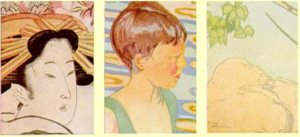
Full-size fragments of three color-prints showing three methods of mitigating hard edges.
An obvious method for mitigating hard edges is to engrave shade lines as you draw them with a pen, a pencil, or an etching needle.
THE SUBJECT. Any subject is suitable provided it is of sufficient interest, but the design must be very carefully considered, and plenty of time and thought given to its construction. It is a responsible undertaking, the making of prints. You may be guilty of perpetrating an ineffable painting, but make a print of it and your crime is a hundred times worse. Subjects may be sought from among your paintings, or in your sketch-book, or you may deliberately make drawings with a print in view. Any medium may be used for recording suitable ideas. The Japanese artist invariably drew with a brush, but since a long and arduous apprenticeship gave him facility with this instrument, and you have not had that advantage, I would not recommend it. "It looked very simple," wrote Mrs. Bertha Jaques, in her delightful monograph on Helen Hyde, "and I secretly thought it easy to do; but repeated trials convinced me that such skill is not Heaven-born with the unpractised occidental."
While a line and wash drawing would suit Mr. Platt, Mr. Giles would work from a painting in full color. Whatever the medium a cartoon in color is usually made, wherein form is very carefully defined, and due regard has been given to the simplification of its color scheme, its tonal effects and shapes, to accord with the number of blocks to be used. Some of the tonal and chromatic subtleties which you seem to sacrifice here may be picked up again in printing.
The first block you engrave must serve as a key for those that follow, and therefore must embrace as much of the design as possible. It may not be a pure line block at all. Make it a prevailing color if you like—in a figure the color of the flesh shadows; in a sunlit landscape the sun shadows—purple or gray.
Whatever color you select trace it out upon a sheet of, say, rice paper in soft pencil, or pen or brush and water-proof ink. Place this tracing between sheets of damp newspaper, and let it absorb moisture whilst we meditate upon the many varieties of wood, and a little longer upon the key-block.
Two or more planes in a picture often necessitate the cutting of two line blocks.
A key-block may be cut with every form outlined, irrespective of tone or color, and in the final printing may be eliminated wholly or in part.
Outline may be avoided also by a system of additions in which succeeding color-blocks are printed to form a key for the next: thus 1 is the key for 2, 1 and 2 for 3, 1, 2 and 3 for 4, and so on.
An alternative method: Make your cartoon in color on stout tracing paper, which may be conveniently stretched in a double frame, and trace each color as required directly upon the wood.